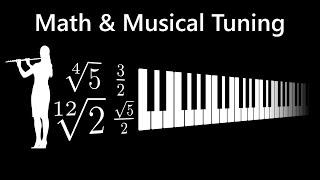
The Mathematical Problem with Music, and How to Solve It
Комментарии:

Very well researched, presented and produced! This is a digestible introduction into a complex matter.
Ответить
Well done -
Ответить
Why is the 2:1 ratio called an octave, a word which suggests the number 8? And why 3:2 a fifth? Because 3+2=5?
Ответить
This was such an amazing video. I only started taking interest in music a few years ago and never attended any lectures, so my knowledge of the more complex aspects of music theory is very limited. Because of this I often have problems understanding videos of this type, trying to explain the connection between math/physics and music. This was the first video I understood completely and it kinda blew my mind to be honest. Fantastic job. Thank you so much.
Ответить
As a guitar beginner, I strummed to play the harmonic above the 19th fret (B on the E string) to find it's just the (nearly) 1/3 length of the string, and B is the fifth note of E major. I proceeded to check the 1/2 length (the 12th fret) to find the same pitch name for 1/1 length, and guessed human brain just use the logarithm, whose base number is 2, to make the cycle. So the interval of half note is just geometrically dividing into 12 pieces, and what makes the fifth note so special is that 2^(19/12) ≈ 3. I've been looking for a music-theory book under advanced mathematics to get a further scope about harmony theory, which plays an important role in constructing chord on guitar. Thanks for affording the links below and your Manim programming is so fabulous for me to check the history of what I've known before.
Ответить
Perhaps the problem lies with wanting to transpose melodies
Ответить
Mfw no infinite key piano :[
Ответить
Could def hear it was higher even on crappy earpods
Ответить
How to solve it: Play a just intonation instrument.
Ответить
Thanks for the awesome presentation, very clear and detailed, will definitely save it to show students!
Ответить
I have a 1927 wurlizer ...
I had my tech...restore it. And keep it at 432.

Hey there! I hope you're doing well. I wanted to get in contact with you regarding this research paper I wrote for tuning systems using this video as my foundation and just wanted to confirm some stuff with you! Thank you.
Ответить
So that means...
There was history of musical melodies...

This is the best video I have seen on this subject for beginners like me.. THANKS A TON SIR
Ответить
Hi sir - I have a question - so in a nutshell does it mean that the basis of any tuning in western music is to primarily achieve 2 goals - one is to capture perfect fifths of each note in the instrument and the 2nd goal is ability to transpose? I have no concept of music theory hence my question might be too naive... so if we have the keys of a piiano say tuned at any AP series, then transposition problem would be resolved but the "square root of 2"f formula addresses transposition as well as accomodates the perfect 5th (well not exactly perfect but almost) hence we chose that. Is that a correct understanding?
Ответить
This is fascinating. I'm an electronics engineer so I understand and work with harmonics and octaves all day long but have always wondered about musical tunings and why there are "missing" black notes. I shall now be able to write my masterwork with my discrete note theramin.
Ответить
Wow, no one has solved yet this problem within just intonation till this day
Ответить
Great video, thanks! I’ve always equated tuning systems to earths imperfect rotation and thus the need for leap-year. Calendars and tuning systems: The bane of humanity.
Ответить
It's a made up problem. As the brain processes sound relatively, it makes absolutely zero difference whether or not something is """perfectly in tune"""
The difference between a perfect third, and an equal temperament third actually is none. The difference only exists when they're compared directly to each other through physical comparison, or by comparing your memory of the note, with what you're hearing in the moment.

Excellent assessment
Ответить
But to what temperament should I stay tuned to?
You can't leave me on a cliff hanger like that!

I actually quite liked the sound of the well-tempered klavier transposed in JI. The intervals you get are still just intervals, just different ones
Ответить
I have already solved it. My guitar is completely mechanically POLYPHONIC without the use of any computer or electrical devices whatsoever. You create the 'mathmatical' box and paradox completely unecessarily. You do this by forcing C to be 261.whatever HZ while at the same time force 440HZ to be A. Then you use another falicy called 'CENTS' to govern the cent relationship by a span of 1200 cents per octave by the ratios. This is what causes your endless WRONG calculations by THE WRONG INPUTS. College cannot teach you anything they do not wish YOU TO LEARN! Enjoy brainwashing yourselves with false teachings from false prophets that you pay extraordinary amounts of money to? It is a scam. Use your ratios to frequencies for the desired outcome, that is all. Do not use cents and do not force a span between C and A by prefixed frequencies! Frequency selection is key to finding proper alignment! Not cents or the other lies. Thank you, thank you. I know. Pulitzer prize, God knows i need the millions of dollars as well. Thanks. All i am ask of thee is the 10%, and i am got beheaded inside a government facility helen ross mcnabb center of knoxville TN for the will and testimony of mine holy father in heaven hallowed be thy name, and the christ, the testimony of the resurection of jesus, and CHRIST and having the CHRIST that jesus taught, CHRIST ALL THINGS POSSIBLE THROUGH GOD!
I am that i am, and i am is not a man. I am and where i am IS the kingdom also. I am that i am is the way, the truth, and the life, that whom so ever believe on i am, have everlasting life. I am is with you always. Those that seek the face of i am shall find the face of i am. Do not be deceived by an angel of light, you shall know that i am, for you shall be in the holy spirit with i am.

excellent breakdown, super clear and fun to follow. Good job!
Ответить
Why not just use equal temperament?
Ответить
Thank You for this work
Ответить
Am i the only one that perceived the outro "Stay tuned" as a joke? Because the whole video was talking about tuning... xD
Ответить
Loved this video. Congratulations
Ответить
one year after : woh again ! 🎉
Ответить
string instruments use all 3!
Ответить
Nice thumbnail
Ответить
If you guys like hard rock, its may be because you are slightly allergic to the dissonant third
Ответить
forever in your debt for this brilliantly clear explanation. Thank you so so very much.
Ответить
Wow, so good. Complete and clear; thank you.
Ответить
"there is a certain tone, let's call it f" plays an E
This messed with my perfect pitch brain a bit too much lol

Finally, a video I want to watch while eating.
Ответить
Great video. Thank you
Ответить
i only need powerchords brah you could've stopped there
Ответить
An excellent introduction to the subject. Thank you. It occurs to me that where tunings are defined using irrational numbers (eg square root of 5) then that note can never be exactly achieved - it being possible only to approximate these numbers.
Ответить
i wish you had a list of your resources and references i want to make a research project around this topic
Ответить
Brilliant, thanks
Ответить
This thing is amazing. And also you have helped me understand music SO much better. Thank you very much i love the video!
Ответить
Guy don't know his notes
Ответить
Its such a great video. I knew that a lot of maths go behind music, but this gave a good foundation for it. I recently started learning to play Piano which led me to Music Theory which in turn led me to this video. Thanks for making this ❤
Ответить
i always wanted someone to explain this to me, so clearly and eloquently. great work. thanks Yuval
Ответить


























